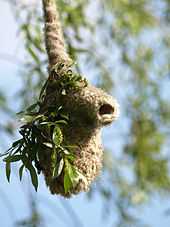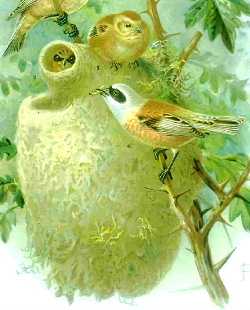Penduline tit
| Penduline tits | |
|---|---|
 | |
| Verdin (Auriparus flaviceps) | |
| Scientific classification | |
| Kingdom: | Animalia |
| Phylum: | Chordata |
| Class: | Aves |
| Order: | Passeriformes |
| Suborder: | Passeri |
| Family: | Remizidae (but see text) Olphe-Galliard, 1891 |
| Genera | |
|
Remiz | |
The penduline tits constitute a family of small passerine birds, related to the true tits. All but the Verdin and Fire-capped Tit make elaborate bag nests hanging from trees (whence "penduline", hanging), usually over water; inclusion of the Fire-capped Tit in this family is disputed by some authorities[citation needed].
Characteristics
Penduline tits are tiny passerines, ranging from 7.5 to 11 cm in length, that resemble the true tits (Paridae) but have finer bills with more needle-like points. Their wings are short and rounded and their short tails are notched (except the stub-tailed tit). The penduline tits' typical plumage colors are pale grays and yellows and white, though the European Penduline Tit has black and chestnut markings and some species have bright yellow or red (Perrins 2003).
Distribution and habitat
The penduline tits live in Eurasia and Africa and North America. The genus Remiz is almost exclusively Eurasian, ranging discontinuously from Portugal and the tip of northern Morocco through to Siberia and Japan. The largest genus, Anthoscopus, is found in sub-Saharan Africa from the Sahel through to South Africa. Of the monotypic genera the Verdin lives in arid parts of the southwestern U.S. and northern Mexico, the Fire-capped Tit is found in Southern and Eastern Asia, and the Tit-hylia in eastern and central Africa.
Several species of penduline tit are migratory, although this behaviour is only shown in species found in Asia and Europe; African species and the Verdin are apparently sedentary. The Eurasian Penduline Tit is migratory over parts of its range, with birds in northern Europe moving south in the winter but birds in southern Europe remaining close to their breeding areas. In contrast The Chinese Penduline Tit and Fire-capped Tit are fully migratory and undertake long distance migrations.
Most live in open country with trees or bushes, ranging from desert to marsh to woodland, but the Forest Penduline Tit and the Tit-hylia live in rain forest. They spend most of the year in small flocks (Perrins 2003).
Behaviour

Insects form the larger part of the diet of the penduline tits, and they are active foragers. Their long conical bill is used to probe into cracks and prise open holes in order to obtain prey. Nectar, seeds and fruits may also be taken seasonally. Their foraging behaviour is reminiscent of the true tits (Paridae), foraging upside-down on small branches, manoeuvring branches and leaves with their feet in order to insect them, and clasping large prey items with one foot while dismembering them.[1]
The common name of the family reflects the tendency of most species to construct elaborate pear-shaped nests. These nests are woven from spiderweb, wool and animal hair and soft plant materials and is suspended from twigs and branches in trees. The nests of the African genus Anthoscopus are even more elaborate than the Eurasian Remiz, incorporating a false entrance above the true entrance which leads to a false chamber. The true nesting chamber is accessed by the parent opening a hidden flap, entering and then closing the flap shut again, the two sides sealing with sticky spider webs.[1]
Of the two species with aberrant nests, the Verdin builds a domed nest out of thorny twigs and the Fire-capped Tit nests in tree holes that it lines. The eggs are white, with red spots in some species; the Verdin lays blue-green eggs with red spots. Incubation lasts about 13 or 14 days, and the nestlings fledge at about 18 days (Perrins 2003).
Systematics
Sometimes, these birds are included as subfamily Remizinae in the tit family Paridae. Which taxonomic lineup scientists prefers is primarily a matter of taste; that these families are close relatives is well established by now. If the penduline tits are included in the Paridae, the stenostirid "warblers" would have to be included as another subfamily, while if they are considered a separate family, the Sultan Tit and the Yellow-browed Tit would possibly need to be excluded from the Paridae (Jønsson & Fjeldsa 2006).[2] The placement of the Tit-hylia within this family is particularly controversial, it having variously been placed with the sunbirds, waxbills, honeyeaters and most recently close to the Green Hylia.[3] It is placed in the Cettiidae family.
There are 12 species in 5 genera, following Harrap & Quinn (1996): Family: REMIZIDAE
- Genus: Remiz
- Eurasian Penduline Tit (Remiz pendulinus)
- Black-headed Penduline Tit (Remiz macronyx)
- Chinese Penduline Tit (Remiz consobrinus)
- White-crowned Penduline Tit (Remiz coronatus)
- Genus: Anthoscopus
- Grey Penduline Tit (Anthoscopus caroli)
- Forest Penduline Tit (Anthoscopus flavifrons)
- Cape Penduline Tit (Anthoscopus minutus)
- Mouse-colored Penduline Tit (Anthoscopus musculus)
- Yellow Penduline Tit (Anthoscopus parvulus)
- Sennar Penduline Tit (Anthoscopus punctifrons)
- Genus: Cephalopyrus
- Fire-capped Tit (Cephalopyrus flammiceps)
- Genus: Auriparus
- Verdin (Auriparus flaviceps)
-
.jpg)
Cape Penduline Tit (Anthoscopus minutus)
-
.jpg)
Grey Penduline Tit (Anthoscopus caroli)
References
- Harrap, Simon & Quinn, David (1996): Tits, Nuthatches & Treecreepers. Christopher Helm, London. ISBN 0-7136-3964-4
- Jønsson, Knud A. & Fjeldså, Jon (2006): Determining biogeographical patterns of dispersal and diversification in oscine passerine birds in Australia, Southeast Asia and Africa. J. Biogeogr. 33(7): 1155–1165. doi:10.1111/j.1365-2699.2006.01507.x (HTML abstract)
- Perrins, Christopher M. (2003): "Penduline Tits". In Perrins, Christopher (editor): The Firefly Encyclopedia of Birds. Firefly Books. ISBN 1-55297-777-3.
- ↑ 1.0 1.1 Madge, Steve (2008). "Family Remizidae (Penduline-tits)". In Josep, del Hoyo; Andrew, Elliott; David, Christie. Handbook of the Birds of the World. Volume 13, Penduline-tits to Shrikes. Barcelona: Lynx Edicions. pp. 52–75. ISBN 978-84-96553-45-3.
- ↑ Gill, Frank B; Slikas, Beth & Sheldon, Frederick H. (2005). "Phylogeny of titmice (Paridae): II. Species relationships based on sequences of the mitochondrial cytochrome-b gene.". Auk 122: 121–143. doi:10.1642/0004-8038(2005)122[0121:POTPIS]2.0.CO;2.
- ↑ Sefc, KM; Payne, R.B. & Sorenson, M.D. (2003). "Phylogenetic relationships of African sunbird-like warblers: Moho Hypergerus atriceps, Green Hylia Hylia prasina and Tit-hylia Pholidornis rushiae". Ostritch 74 (1-2): 8–17.
External links
- Penduline tits photos & videos on the Internet Bird Collection
